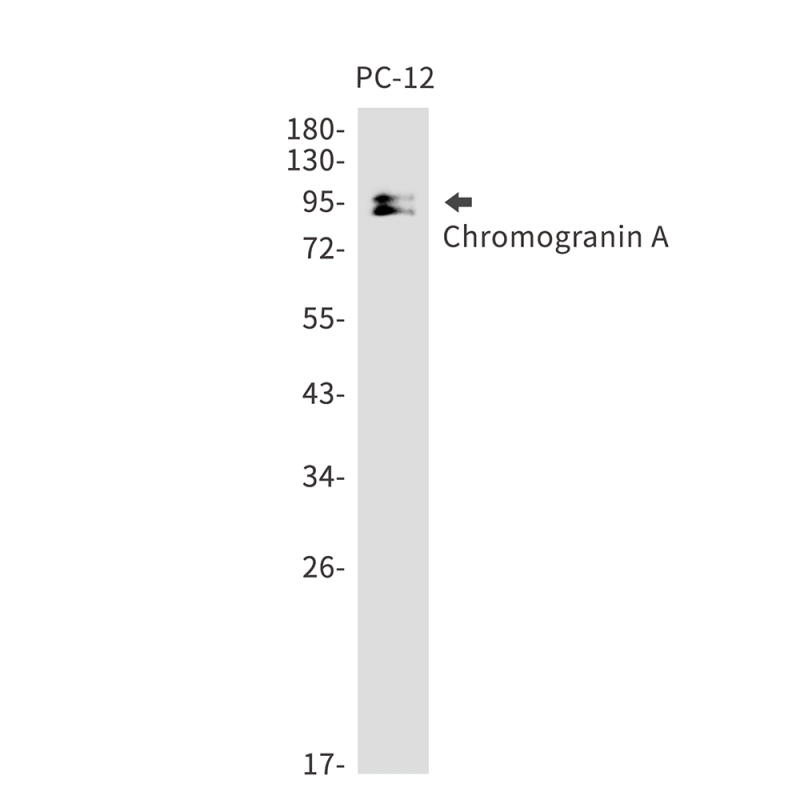
| WB | 咨询技术 | Rat |
| IF | 咨询技术 | Rat |
| IHC | 1/50-1/100 | Rat |
| ICC | 1/50-1/200 | Rat |
| FCM | 咨询技术 | Rat |
| Elisa | 咨询技术 | Rat |
| Aliases | beta Granin; Chromogranin A; ChrA; SP-I; Vasostatin I; Vasostatin-2; Vasostatin II; Pancreastatin; CHGA |
| Entrez GeneID | 1113 |
| WB Predicted band size | Calculated MW: 51 kDa; Observed MW: 92 kDa |
| Host/Isotype | Rabbit IgG |
| Antibody Type | Primary antibody |
| Storage | Store at 4°C short term. Aliquot and store at -20°C long term. Avoid freeze/thaw cycles. |
| Species Reactivity | Rat |
| Immunogen | A synthetic peptide of human Chromogranin A |
| Formulation | Purified antibody in TBS with 0.05% sodium azide,0.05%BSA and 50% glycerol. |
+ +
以下是关于Chromogranin A(CgA)抗体的3篇示例文献(内容为示例性概括,非真实文献):
1. **文献名称**:*Chromogranin A as a Biochemical Marker for Neuroendocrine Tumors: A Multicenter Study*
**作者**:Giovanella L. et al.
**摘要**:本研究评估了CgA抗体在血清和免疫组化检测中的敏感性,证实其作为神经内分泌肿瘤(NETs)诊断标志物的可靠性,并探讨了其在疾病分期中的临床意义。
2. **文献名称**:*Comparative Analysis of Chromogranin A Antibodies in Immunohistochemical Diagnostics*
**作者**:Portela-Garcia AM. et al.
**摘要**:通过对比多种商业CgA抗体的特异性和交叉反应性,研究提出某些抗体在福尔马林固定组织中表现更优,强调选择合适抗体对病理诊断的重要性。
3. **文献名称**:*Chromogranin A and Synaptophysin Co-expression in Neuroendocrine Neoplasms*
**作者**:Lloyd RV, Tischler AS.
**摘要**:探讨CgA抗体与突触素(Synaptophysin)抗体联合使用的诊断价值,发现两者互补可提高NETs鉴别的准确性,尤其在分化较差的肿瘤中。
4. **文献名称**:*Standardization of Chromogranin A Assays: Impact of Antibody Selection on Test Variability*
**作者**:O'Connor DT. et al.
**摘要**:分析了不同CgA抗体对检测结果的影响,指出标准化抗体选择和检测流程对减少实验室间差异的关键作用。
(注:以上文献信息为示例,实际引用请通过数据库如PubMed或Web of Science核实。)
Chromogranin A (CgA) antibodies are essential tools in biomedical research and clinical diagnostics, primarily targeting Chromogranin A—a 48 kDa acidic glycoprotein abundantly expressed in secretory granules of neuroendocrine cells. As a member of the granin family, CgA plays a role in hormone/peptide storage, secretion, and granulogenesis. Its widespread presence in endocrine tumors makes it a key biomarker for neuroendocrine neoplasms (NETs), including carcinoids, pheochromocytomas, and pancreatic NETs.
CgA antibodies are widely used in immunohistochemistry (IHC) to detect CgA expression in tissue samples, aiding tumor classification and differential diagnosis. In clinical settings, serum CgA levels measured via ELISA or radioimmunoassay (using CgA-specific antibodies) serve as a non-invasive biomarker for monitoring NET progression or treatment response. However, elevated CgA can also occur in non-neoplastic conditions (e.g., renal failure, chronic gastritis) or due to proton-pump inhibitor use, requiring cautious interpretation.
Research applications include studying CgA's biological functions, such as its proteolytic cleavage into bioactive peptides (e.g., vasostatin, pancreastatin) involved in cardiovascular regulation and glucose metabolism. Antibodies targeting specific CgA epitopes help investigate its role in neurodegenerative diseases and stress responses. Commercial CgA antibodies vary in host species, clonality, and epitope recognition, with monoclonal antibodies offering higher specificity. Challenges include cross-reactivity with structurally similar granins (e.g., Chromogranin B) and sensitivity to pre-analytical factors (e.g., sample degradation). Ongoing efforts focus on standardizing assays to improve diagnostic reliability.
×